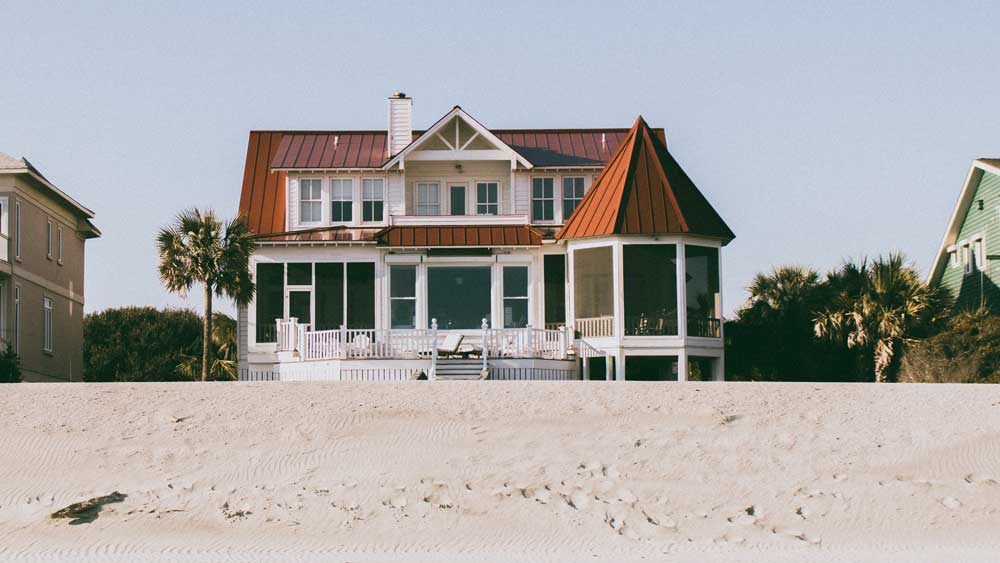
How to Buy a Beach House: Setting the Stage
Whether you’re buying a beach house as a primary residence or a second home, you will need to take into account the unique characteristics of such properties before buying. The same is true whether you are buying a beach house in Tofino, British Columbia or Corpus Christi, Texas, although each location will have its own unique considerations. From understanding zoning restrictions as an owner of a waterfront home to considering house elevation and weather preparedness, there are many things to look into. With this in mind, we’ve outlined some of these consideration below and other useful tips for buying a beach house. Here’s how to buy a beach house in five easy steps.
1. Understand Your Finances
Understanding how much you can afford is an important first step so that you better understand your budget. If you’re buying your beach house as a vacation home, click here for a useful overview of affordability criteria. Next, you will need to secure a mortgage. Importantly, be sure to secure a mortgage before you start looking for a beach house. This is especially true in a competitive market, as sellers will want to deal with qualified buyers.
For a traditional mortgage on a primary residence, competitive rates are available given the low interest rate environment. If your beach house will be used as a vacation home, note that most lenders will have stricter lending criteria because the risk of default is higher with a second home. Mortgages for second homes are also often coupled with higher interest rates (e.g. 0.25% to 0.50% higher) and larger down payment requirements (e.g. 20-30% instead of 5-10%).
Once you’ve secured a mortgage, prepare a detailed budget to ensure you’re comfortable with the monthly mortgage payments and beach house expenses. Try our mortgage calculator and vacation home cost calculator to help generate your budget. When preparing your budget, be mindful that waterfront properties can carry additional expenses, such as higher water and sewer rates, higher insurance fees (especially if the area is prone to flooding or hurricanes), boat dock and lift fees, as well as septic tank and well upkeep costs.
2. Settle on a Location

If you haven’t yet settled on a location, do some research of popular beach destinations in the locations you’re interested in. Narrow down locations based on real estate prices (and what you can afford), activities available in the area, climate and other relevant criteria. Once you settle on a general area (or areas) stay in a vacation rental close by to get a feel for it. If you like one particular area over others, then narrow your search accordingly. From there, find a qualified realtor that specializes in waterfront properties in the area.
3. Work With a Knowledgeable Realtor to Find the Perfect Beach House
A knowledgeable realtor that has experience buying and selling waterfront properties in the area will be an invaluable resource. They should understand the local market and know what to look out for when buying a beach house. A good realtor will not only have access to MLS listings but also properties that have not yet been listed but may be available for purchase. This may include first access to listings before they reach the general public or even properties that aren’t listed at all.
With help from your realtor, now comes the fun part of searching for, and viewing, available properties. Remember to be patient as it can take some time to find the right property. Once you’ve found the perfect beach house, submit an offer and sign an agreement to purchase. The agreement to purchase should be subject to a satisfactory inspection and review of appropriate documentation.
4. Conduct Appropriate Due Diligence
Beach houses have their own unique set of considerations and therefore its important to conduct appropriate due diligence prior to closing the purchase and sale. In particular:
Understand zoning regulations and restrictions
First, you will need to understand what restrictions there are on what you can build on the property. Governmental regulations on waterfront properties govern such things as site density, minimum setbacks from the water, the kinds of uses that are permitted and even design and construction. Further, are you able to build a dock or maintain an existing one? Can you build or maintain a seawall? The answers to these questions will need to be understood before you purchase. Separately, if you plan on renting out your beach house, are there short term rental regulations in place in the area? Be sure to check whether short term rental restrictions currently exist and consider whether they might change in the future.
Understand what you own
In the United States, the State owns the land below the water and the United States has an overriding interest in preserving public navigation. The waterfront property owner has the right to access and accretion (such as sand build-up over time).
In Canada, Federal and Provincial rules dictate that you only own up to the foreshore, meaning that your property goes just to the high water mark, and you must permit access across the publicly owned land below. As an owner of a beach house in Canada, you have the right of access, the right to protect your property from erosion and the right to accretion as land builds up over time.
Be sure to review the legal description to determine where the lot extends. In some cases, the property boundary could end well before the water’s edge. Also, it will be important to determine whether there are any additional encumbrances on title that would otherwise limit your use of, or access to, the waterfront.
Hire a qualified home inspector and other appropriate experts
In addition to the usual house inspection touchpoints, corrosion caused by salt in the air and mildew and mold issues from higher moisture levels can all wreak havoc on a waterfront property. Boundary surveys, elevation certificates and water quality tests can also be important for a waterfront property. For instance, how far above sea level or the lake shore is the house? Is the area prone to flooding? As sea levels have been rising at a rate of 3.2 millimeters per year, and are expected to rise even more quickly by the end of the century, be sure that the beach house is built at an adequate elevation.
5. Close and Enjoy

At closing, you will sign various documents that will transfer money to the seller and transfer ownership of the beach house to you. After the transfer of ownership, you will get the keys to your beach house and you can now enjoy your home!
Other Tips on How to Buy a Beach House
Here are some other useful tips for buying a beach house:
- Confirm that reliable cell phone and internet service is available in the area as certain coastline communities may have spotty reception.
- Install a security system with remote monitoring so that you can keep tabs on the property while its vacant.
- Consider storm-proofing the beach house by adding storm shutters and stainless steel finishings to fight corrosion from salt in the air.
- If this will be owned as a second home, appropriate tax advice should be sought to better understand the tax consequences of ownership.
We hope you’ve enjoyed this article on how to buy a beach house. Be sure to explore our other articles on buying a vacation home including our checklist on buying your first vacation home.
